Predicting the Compressive Strength of Green Concrete at Various Temperature Ranges Using Different Soft Computing Techniques
Abstract
:1. Introduction
2. Research Objective
3. Methodology
4. Statistical Analysis
4.1. Temperature
4.2. Water-to-Binder Ratio (w/b)
4.3. GGBFS to the Binder Ratio
4.4. Fine Aggregate
4.5. Coarse Aggregate
4.6. Superplasticizer
5. Correlation Matrix between Independent and Dependent Variables
6. Models
6.1. Linear Regression Model (LR)
6.2. Nonlinear Regression Model (NLR)
6.3. Quadratic Regression Model (Q)
6.4. Full Quadratic Regression Model (FQ)
6.5. Artificial Neural Network (ANN)
7. Assessment Criteria for Model
8. Results and Discussions
8.1. Linear Regression Model (LR)
8.2. Nonlinear Regression Model (NLR)
8.3. Quadratic Regression Model (Q)
8.4. Full Quadratic Regression Model (FQ)
8.5. Artificial Neural Network (ANN)
9. Model Comparison
10. Sensitivity Analysis
11. Conclusions
- Insignificant relationships were found between the input parameters and compressive strength, indicating the influence of multiple factors on concrete compressive strength.
- The correlation matrix analysis emphasized the need to consider multiple parameters, as no single attribute alone can determine compressive strength.
- Different models, including linear regression, nonlinear regression, quadratic, and full quadratic models were developed to predict compressive strength, considering various parameters and their interactions.
- An artificial neural network (ANN) model captured complex relationships within the dataset.
- Overall, the sensitivity analysis results derived from the quadratic model provide valuable insights into the relative impact of input factors on the compressive strength of concrete when GGBFS is employed as a cement substitute.
- The ANN model was the most reliable model in predicting the compressive strength of concrete containing GGBSF.
- The study contributes to a better understanding of factors influencing the compressive strength of GGBFS-containing concrete and provides insights for optimizing concrete mixtures and cement replacement with GGBFS.
- The developed models offer practical tools for optimizing concrete mixtures, enhancing durability, and promoting sustainable design principles.
- Adopting these approaches can contribute to global efforts in mitigating climate change and achieving a more sustainable future in the construction industry.
- Sensitivity analysis of the results revealed several significant findings concerning the compressive strength of concrete, particularly concerning the quadratic model and its corresponding input parameters. The water-to-binder ratio was identified as the most influential factor in determining the compressive strength, indicating that GGBFS exhibited behavior similar to that of other input factors.
- Based on the model outcomes, the w/b has the greatest impact on the change in the compressive strength of concrete than did the other model parameters.
Author Contributions
Funding
Institutional Review Board Statement
Informed Consent Statement
Data Availability Statement
Conflicts of Interest
Abbreviations
| LR | Linear Regression |
| NLR | Nonlinear Regression |
| Q | Quadratic |
| FQ | Full Quadratic |
| ANN | Artificial Neural Network |
| R2 | Coefficient of Determination |
| MAE | Mean Absolute Error, MPa |
| SI | Scatter Index, MPa |
| RMSE | Root Mean Square Error, MPa |
| OBJ | The objective function, MPa |
| T | Temperature, °C |
| W/b | Water to Binder Ratio % |
| GGBFS/b | Ground Granulated Blast Furnace Slag to Binder Ratio, % |
| FA | Fine Aggregate, kg/m3 |
| CA | Coarse Aggregate, kg/m3 |
| SP | Superplasticizer, % |
| σc | Compressive Strength, MPa |
| SD | Standard Deviation |
| Skew | Skewness |
| Var | Variance |
| Min | Minimum |
| Max | Maximum |
References
- Flatt, R.J.; Roussel, N.; Cheeseman, C.R. Concrete: An eco material that needs to be improved. J. Eur. Ceram. Soc. 2012, 32, 2787–2798. [Google Scholar] [CrossRef]
- Badogiannis, E.; Papadakis, V.; Chaniotakis, E.; Tsivilis, S. Exploitation of poor Greek kaolins: Strength development of metakaolin concrete and evaluation by means of k-value. Cem. Concr. Res. 2004, 34, 1035–1041. [Google Scholar] [CrossRef]
- Roy, D.; Arjunan, P.; Silsbee, M. Effect of silica fume, metakaolin, and low-calcium fly ash on chemical resistance of concrete. Cem. Concr. Res. 2001, 31, 1809–1813. [Google Scholar] [CrossRef]
- Ferraris, C.F.; Obla, K.H.; Hill, R. The influence of mineral admixtures on the rheology of cement paste and concrete. Cem. Concr. Res. 2001, 31, 245–255. [Google Scholar] [CrossRef]
- Chan, W.; Wu, C. Durability of concrete with high cement replacement. Cem. Concr. Res. 2000, 30, 865–879. [Google Scholar] [CrossRef]
- Behnood, A.; Golafshani, E.M. Predicting the compressive strength of silica fume concrete using hybrid artificial neural network with multi-objective grey wolves. J. Clean. Prod. 2018, 202, 54–64. [Google Scholar] [CrossRef]
- Kumar, R.; Samanta, A.K.; Roy, D.S. Characterization and development of eco-friendly concrete using industrial waste—A Review. J. Urban Environ. Eng. 2014, 8, 98–108. [Google Scholar] [CrossRef] [Green Version]
- Oner, A.; Akyuz, S. An experimental study on optimum usage of GGBS for the compressive strength of concrete. Cem. Concr. Compos. 2007, 29, 505–514. [Google Scholar] [CrossRef]
- Chidiac, S.; Panesar, D. Evolution of mechanical properties of concrete containing ground granulated blast furnace slag and effects on the scaling resistance test at 28 days. Cem. Concr. Compos. 2008, 30, 63–71. [Google Scholar] [CrossRef]
- Cheng, A.; Huang, R.; Wu, J.-K.; Chen, C.-H. Influence of GGBS on durability and corrosion behavior of reinforced concrete. Mater. Chem. Phys. 2005, 93, 404–411. [Google Scholar] [CrossRef]
- Song, H.-W.; Saraswathy, V. Studies on the corrosion resistance of reinforced steel in concrete with ground granulated blast-furnace slag—An overview. J. Hazard. Mater. 2006, 138, 226–233. [Google Scholar] [CrossRef]
- Pal, S.; Mukherjee, A.; Pathak, S. Investigation of hydraulic activity of ground granulated blast furnace slag in concrete. Cem. Concr. Res. 2003, 33, 1481–1486. [Google Scholar] [CrossRef]
- Saafan, M.A.; Etman, Z.A.; El Lakany, D.M. Microstructure and Durability of Ground Granulated Blast Furnace Slag Cement Mortars. Iran. J. Sci. Technol. Trans. Civ. Eng. 2021, 45, 1457–1465. [Google Scholar] [CrossRef]
- Douglas, E.; Zerbino, R. Characterization of granulated and pelletized blast furnace slag. Cem. Concr. Res. 1986, 16, 662–670. [Google Scholar] [CrossRef]
- Xu, H.; Gong, W.; Syltebo, L.; Izzo, K.; Lutze, W.; Pegg, I.L. Effect of blast furnace slag grades on fly ash based geopolymer waste forms. Fuel 2014, 133, 332–340. [Google Scholar] [CrossRef]
- Elibol, C.; Sengul, O. Effects of activator properties and ferrochrome slag aggregates on the properties of alkali-activated blast furnace slag mortars. Arab. J. Sci. Eng. 2015, 41, 1561–1571. [Google Scholar] [CrossRef]
- Norrarat, P.; Tangchirapat, W.; Songpiriyakij, S.; Jaturapitakkul, C. Evaluation of Strengths from Cement Hydration and Slag Reaction of Mortars Containing High Volume of Ground River Sand and GGBF Slag. Adv. Civ. Eng. 2019, 2019, 1–12. [Google Scholar] [CrossRef] [Green Version]
- Sarwar, W.; Ghafor, K.; Mohammed, A. Regression analysis and Vipulanandan model to quantify the effect of polymers on the plastic and hardened properties with the tensile bonding strength of the cement mortar. Results Mater. 2019, 1, 100011. [Google Scholar] [CrossRef]
- Sarwar, W.; Ghafor, K.; Mohammed, A. Modeling the rheological properties with shear stress limit and compressive strength of ordinary Portland cement modified with polymers. J. Build. Pathol. Rehabil. 2019, 4, 25. [Google Scholar] [CrossRef]
- Ghafor, K.; Qadir, S.; Mahmood, W.; Mohammed, A. Statistical variations and new correlation models to predict the mechanical behaviour of the cement mortar modified with silica fume. Géoméch. Geoengin. 2020, 17, 118–130. [Google Scholar] [CrossRef]
- Ahmed, H.U.; Mohammed, A.A.; Mohammed, A. Soft computing models to predict the compressive strength of GGBS/FA-geopolymer concrete. PLoS ONE 2022, 17, e0265846. [Google Scholar] [CrossRef] [PubMed]
- Ahmed, H.U.; Abdalla, A.A.; Mohammed, A.S.; Mohammed, A.A.; Mosavi, A. Statistical Methods for Modeling the Compressive Strength of Geopolymer Mortar. Materials 2022, 15, 1868. [Google Scholar] [CrossRef] [PubMed]
- Vujičić, T.; Matijevi, T.; Ljucović, J.; Balota, A.; Ševarac, Z. Comparative analysis of methods for determining number of hidden neurons in artificial neural network. In Proceedings of the Central European Conference on Information and Intelligent Systems, Varazdin, Croatia, 21–23 September 2016; Volume 219. [Google Scholar]
- Ozer, D.J. Correlation and the coefficient of determination. Psychol. Bull. 1985, 97, 307. [Google Scholar] [CrossRef]
- Wang, W.; Lu, Y. Analysis of the Mean Absolute Error (MAE) and the Root Mean Square Error (RMSE) in Assessing Rounding Model. IOP Conf. Ser. Mater. Sci. Eng. 2018, 324, 012049. [Google Scholar] [CrossRef]
- Lee, K.; Lee, H.; Lee, S.; Kim, G. Autogenous shrinkage of concrete containing granulated blast-furnace slag. Cem. Concr. Res. 2006, 36, 1279–1285. [Google Scholar] [CrossRef]
- Kwang-Myong, L.; Ki-Heon, K.; Hoi-Keun, L.; Seung-Hoon, L.; Gyu-Yong, K. Characteristics of autogenous shrinkage for concrete containing blast-furnace slag. J. Korea Concr. Inst. 2004, 16, 621–626. [Google Scholar]
- Wainwright, P.; Rey, N. The influence of ground granulated blastfurnace slag (GGBS) additions and time delay on the bleeding of concrete. Cem. Concr. Compos. 2000, 22, 253–257. [Google Scholar] [CrossRef]
- Li, Q.T.; Li, Z.G.; Yuan, G.L. Effects of elevated temperatures on properties of concrete containing ground granulated blast furnace slag as cementitious material. Constr. Build. Mater. 2012, 35, 687–692. [Google Scholar] [CrossRef]
- Han, I.-J.; Yuan, T.-F.; Lee, J.-Y.; Yoon, Y.-S.; Kim, J.-H. Learned prediction of compressive strength of GGBFS concrete using hybrid artificial neural network models. Materials 2019, 12, 3708. [Google Scholar] [CrossRef] [Green Version]
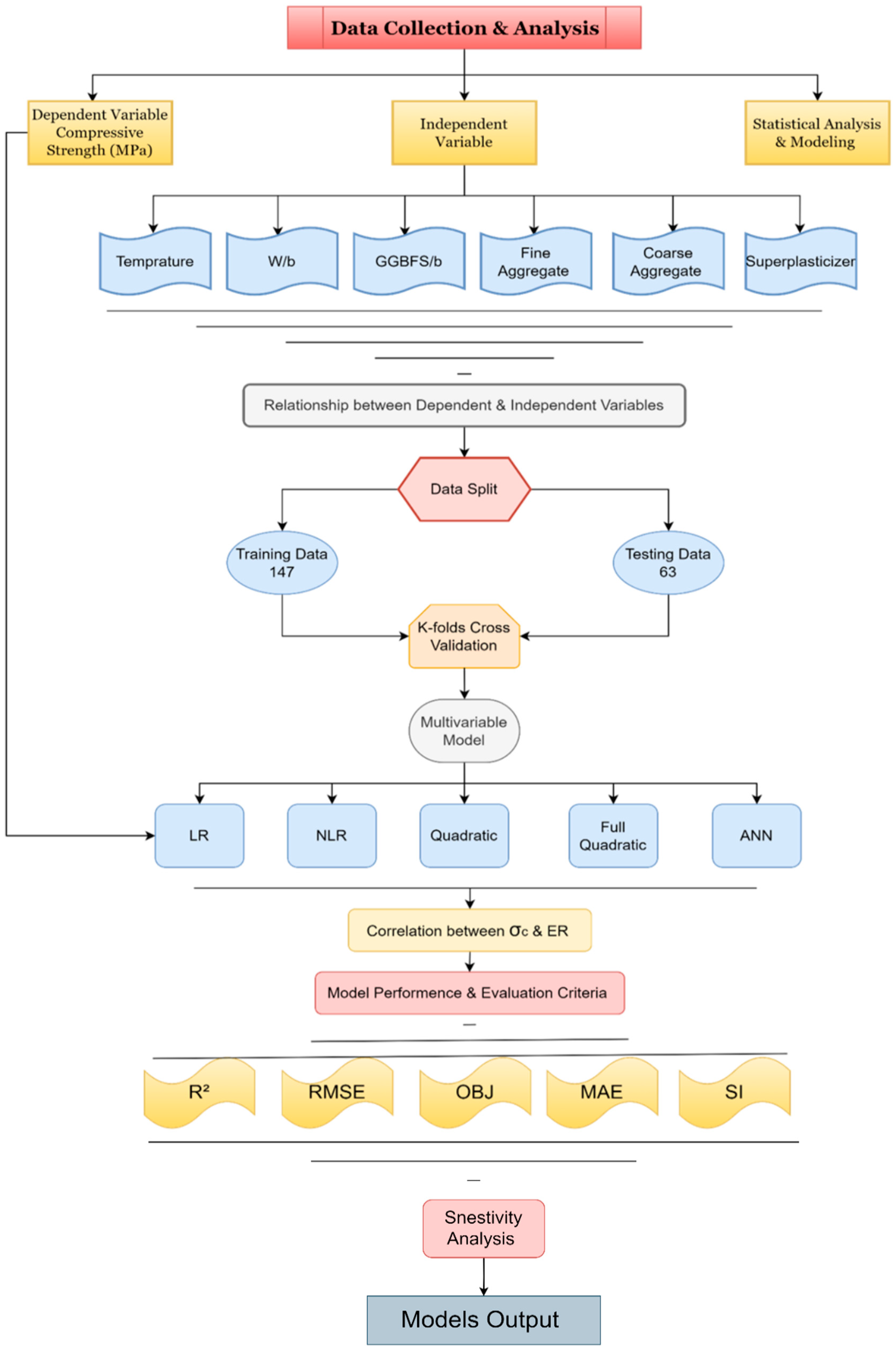
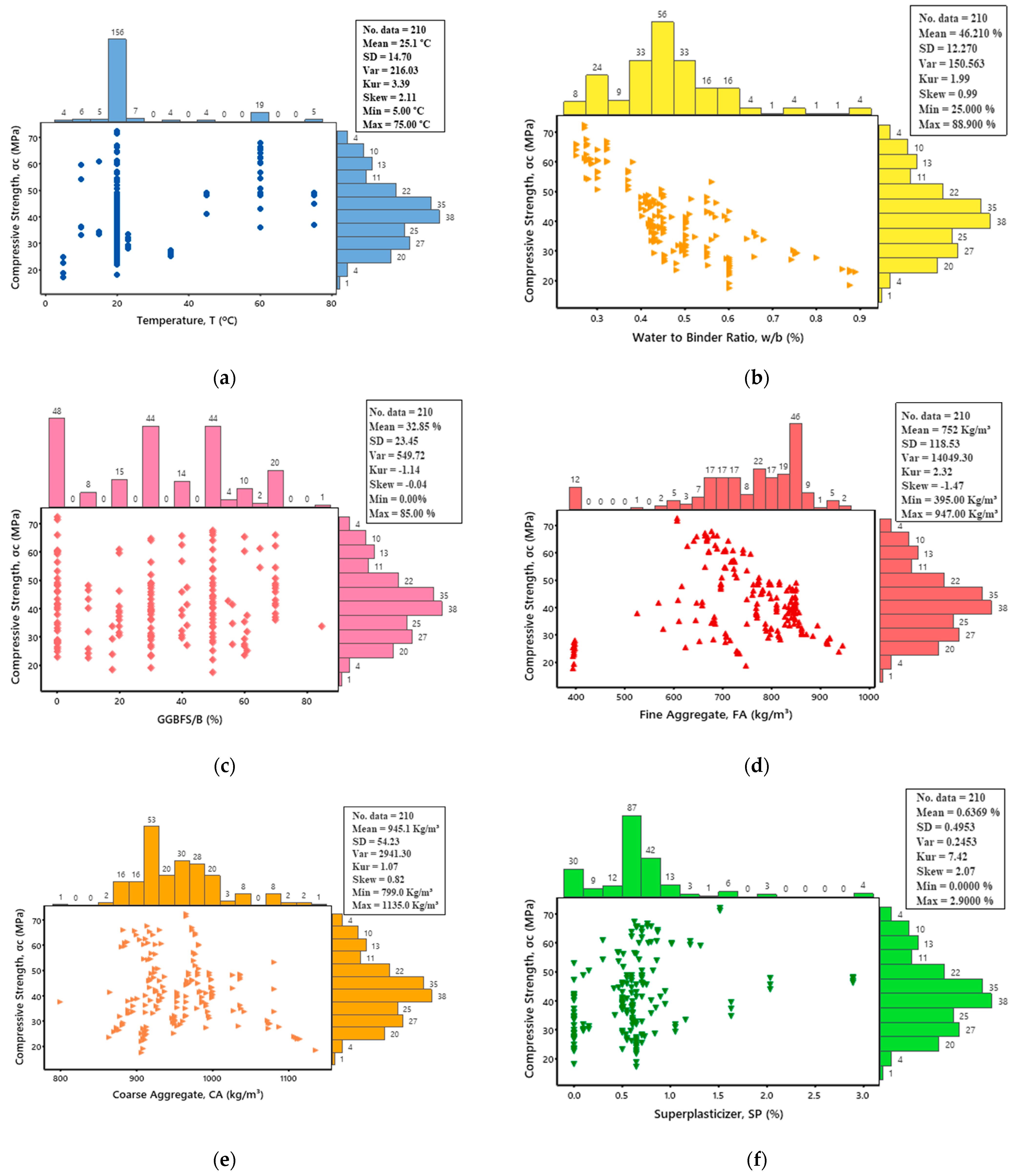


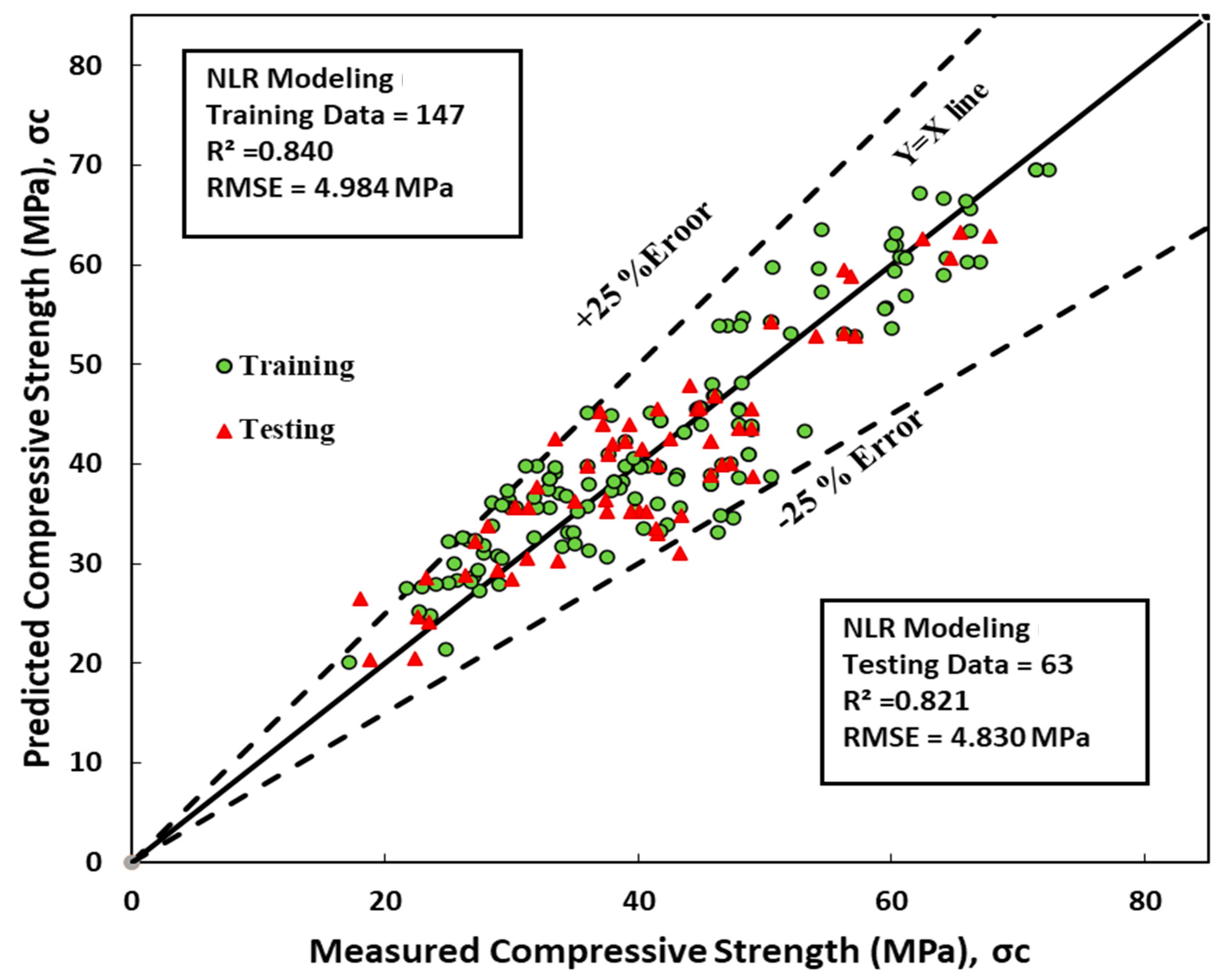
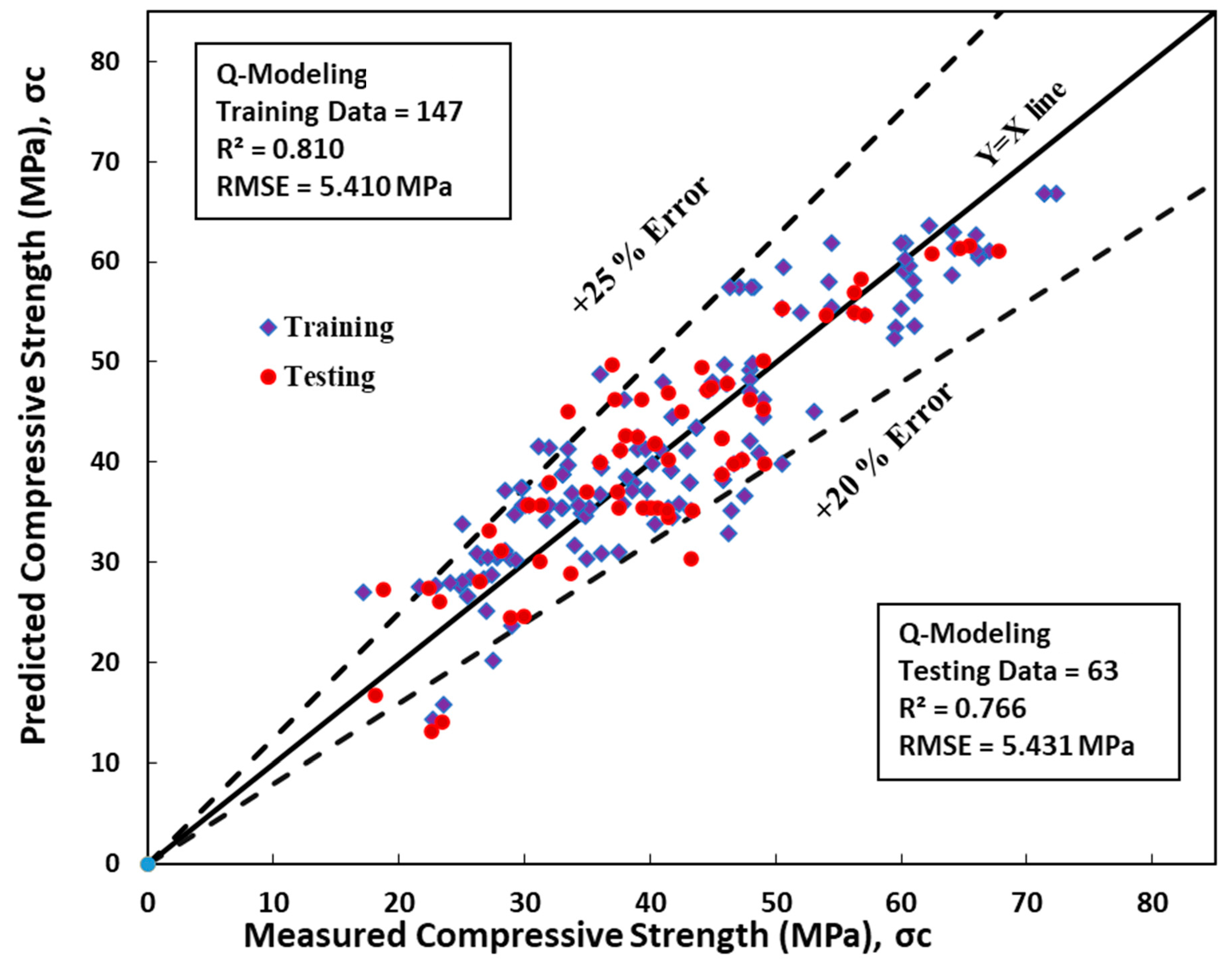
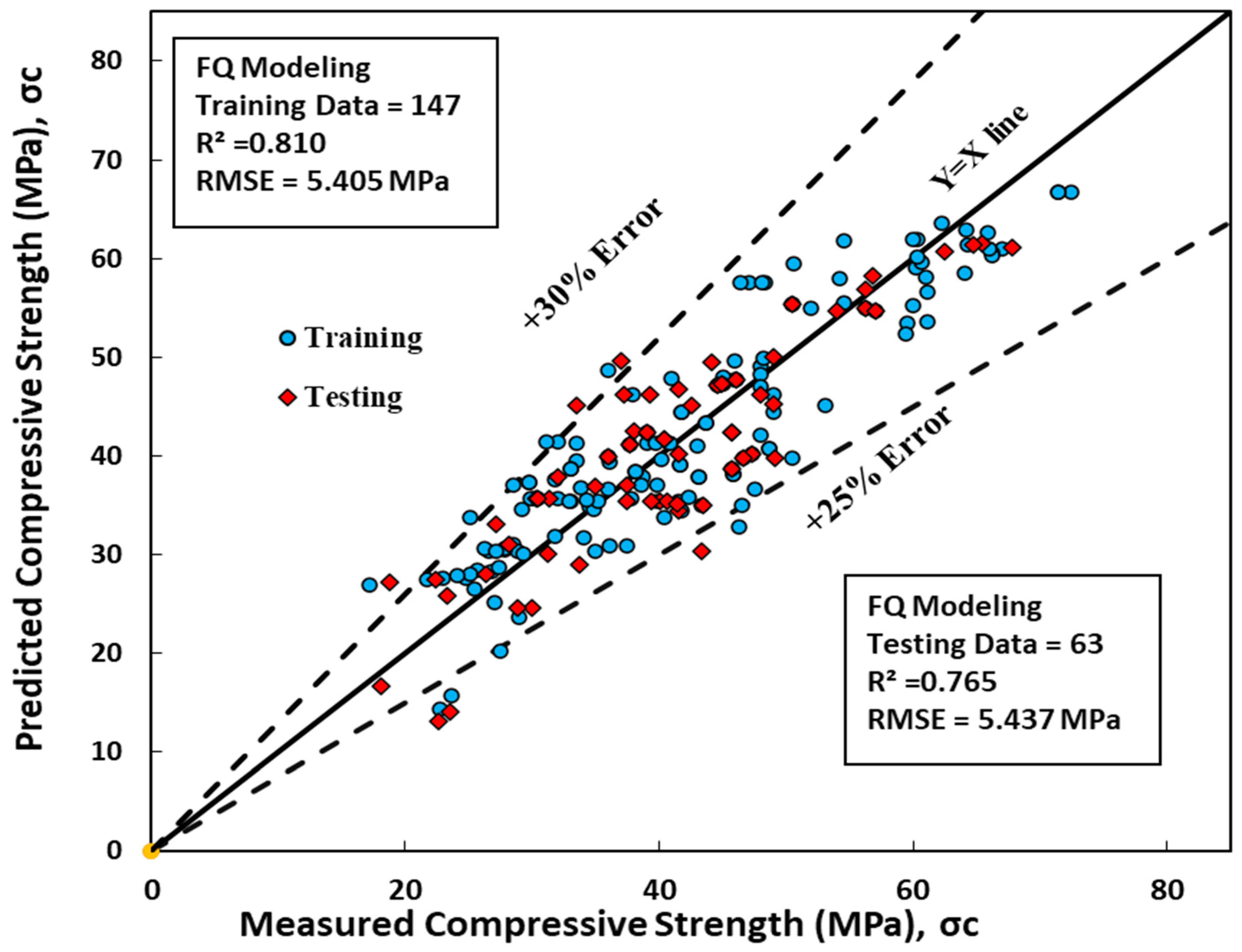



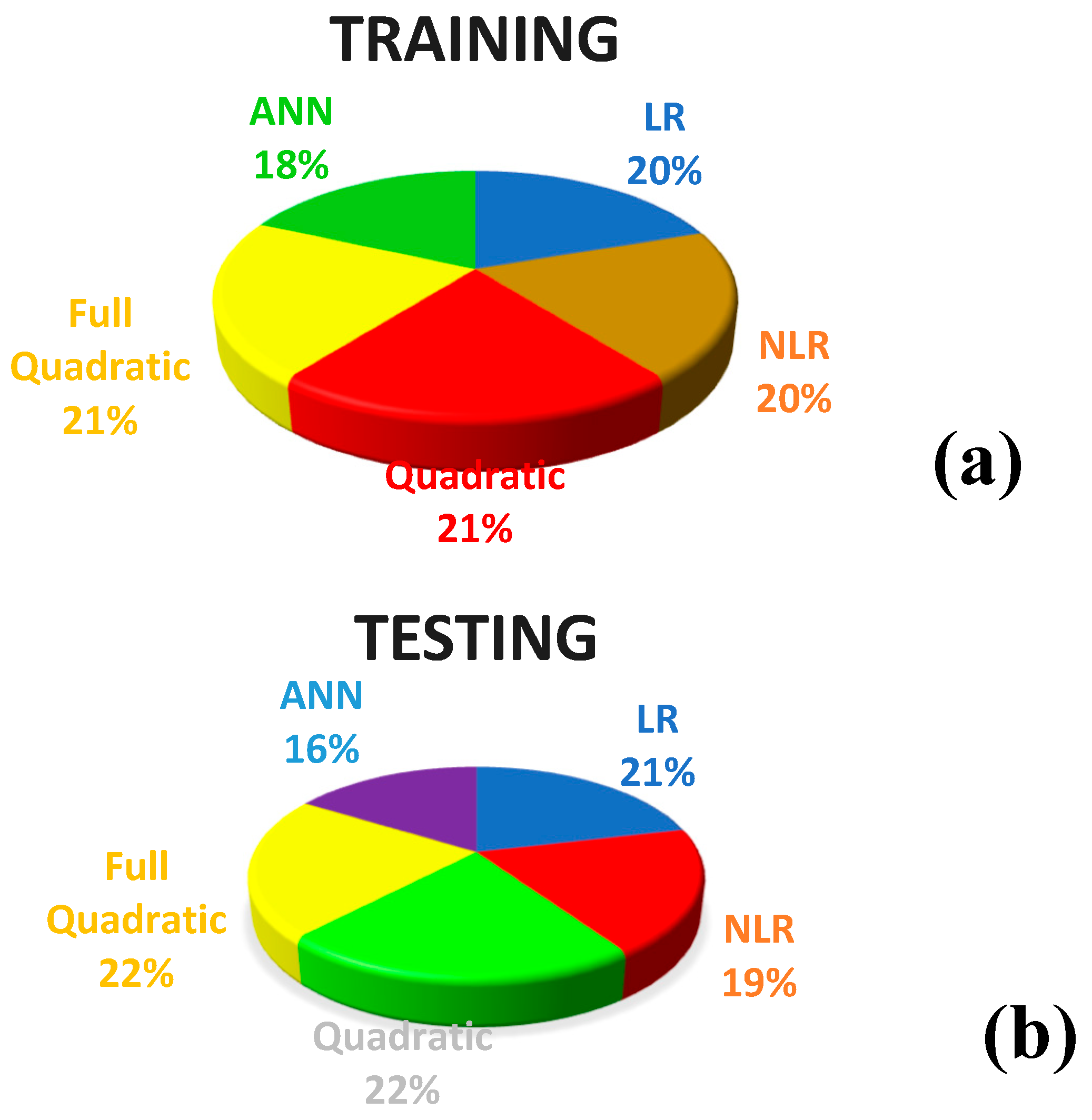

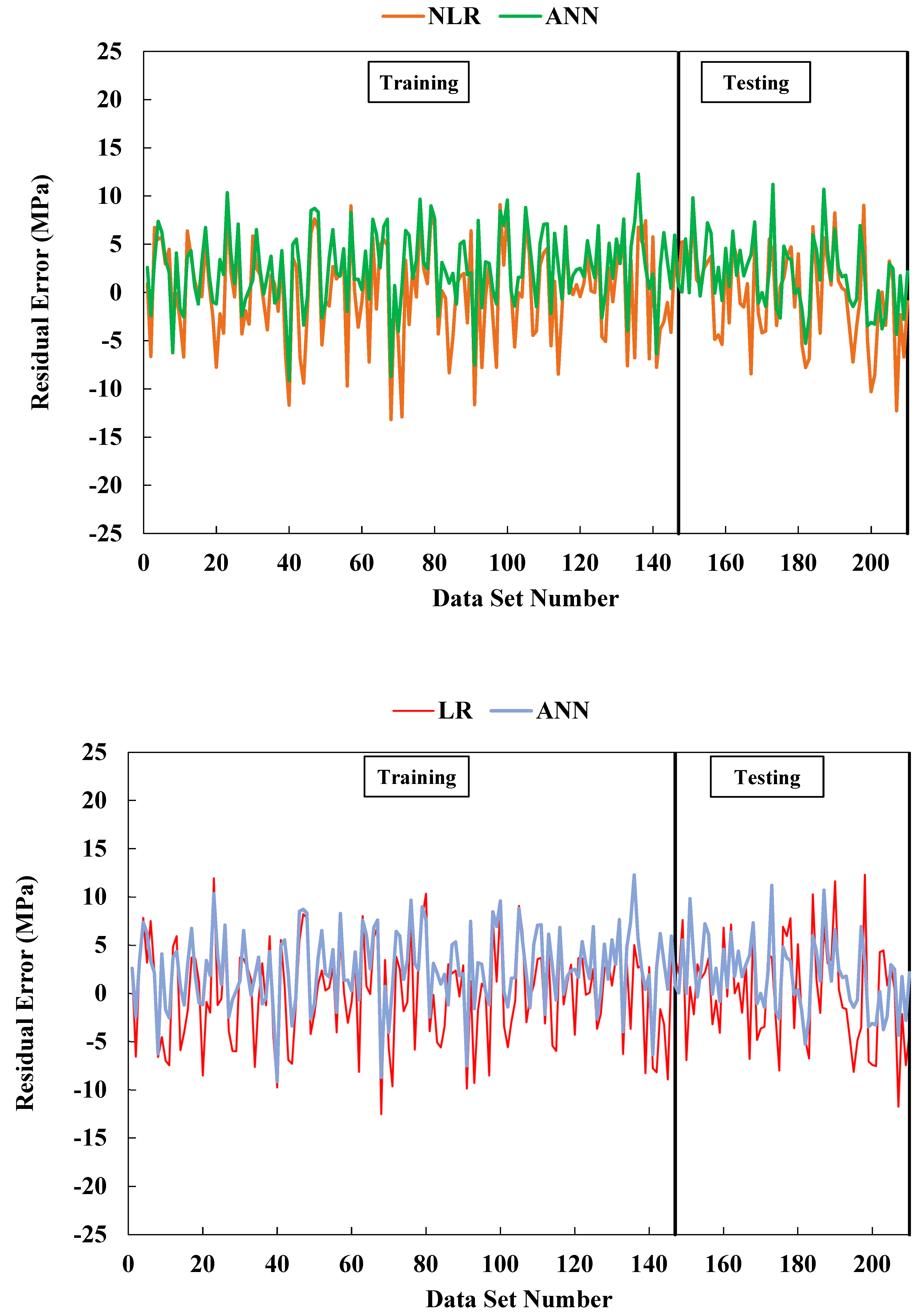

| Reference | No. of Data | Temperature °C | w/b (%) | GGBFS/b (%) | FA (kg/m3) | CA (kg/m3) | Time (Days) | SP (%) | CS (MPa) |
|---|---|---|---|---|---|---|---|---|---|
| [8] | 25 | 20 | 0.442–0.889 | 0–0.61 | 526–748 | 799–1135 | 28 | 0 | 18.1–47.5 |
| [26] | 7 | 20 | 0.27–0.42 | 0–0.5 | 608–780 | 965–981 | 28 | 0.413–1.52 | 44.6–71.4 |
| [27] | 11 | 20 | 0.27–0.445 | 0–0.5 | 608–783 | 923–981 | 28 | 0.15–1.52 | 44.6–71.4 |
| [28] | 2 | 20 | 0.56 | 0.55, 0.58 | 750 | 1080 | 28 | 0 | 33.5,42,5 |
| [29] | 4 | 20 | 0.41 | 0–0.5 | 697 | 1035 | 28 | 2.9 | 46.4–48.3 |
| [30] | 161 | 5–75 | 0.25–0.756 | 0–0.7 | 395–947 | 863–1080 | 28 | 0–2.04 | 17.2–72.4 |
| Remarks | 210 | Ranged between 5–75 | Ranged between | Ranged between | Ranged between | Ranged between | Ranged between | Ranged between | Ranged between |
| 0.25–0.889 | 0–0.7 | 395–947 | 799–1135 | 28 | 0–2.9 | 17.2–72.4 |
| Datasets | Models | R2 | RMSE (MPa) | MAE (MPa) | OBJ (MPa) | Scatter Index |
|---|---|---|---|---|---|---|
| Training | LR | 0.834 | 5.056 | 4.196 | 5.251 | 0.119 |
| NLR | 0.774 | 4.984 | 4.052 | 5.081 | 0.118 | |
| Quadratic | 0.810 | 5.410 | 4.498 | 5.589 | 0.128 | |
| Full Quadratic | 0.810 | 5.405 | 4.468 | 5.576 | 0.127 | |
| ANN | 0.951 | 4.674 | 3.786 | 4.173 | 0.110 | |
| Testing | LR | 0.772 | 5.362 | 4.480 | 1.688 | 0.132 |
| NLR | 0.821 | 4.830 | 4.011 | 1.470 | 0.118 | |
| Quadratic | 0.766 | 5.431 | 4.547 | 1.717 | 0.134 | |
| Full Quadratic | 0.765 | 6.156 | 5.437 | 1.130 | 0.134 | |
| ANN | 0.945 | 4.080 | 3.192 | 1.130 | 0.100 |
| Models | Compressive Strength Ranges (MPa) | No. of Data | R2 | RMSE (MPa) | MAE (MPa) | Scatter Index | Model Performance |
|---|---|---|---|---|---|---|---|
| LR | 15–25 | 13 | 0.931 | 5.198 | 4.699 | 0.237 | Excellent |
| 25–40 | 83 | 0.730 | 5.254 | 4.312 | 0.160 | good | |
| 40–60 | 91 | 0.522 | 5.129 | 4.218 | 0.109 | poor | |
| 60–75 | 23 | 0.956 | 4.813 | 4.182 | 0.074 | Excellent | |
| NLR | 15–25 | 13 | 0.962 | 3.998 | 3.406 | 0.182 | Excellent |
| 25–40 | 83 | 0.813 | 4.494 | 3.799 | 0.137 | Very good | |
| 40–60 | 91 | 0.353 | 5.734 | 4.706 | 0.122 | Poor | |
| 60–75 | 23 | 0.979 | 3.250 | 2.632 | 0.050 | Excellent | |
| Pure Quadratic | 15–25 | 13 | 0.883 | 6.742 | 6.142 | 0.307 | Very good |
| 25–40 | 83 | 0.742 | 5.137 | 4.254 | 0.156 | good | |
| 40–60 | 91 | 0.410 | 5.708 | 4.715 | 0.121 | poor | |
| 60–75 | 23 | 0.965 | 4.244 | 3.725 | 0.066 | Excellent | |
| Full Quadratic | 15–25 | 13 | 0.884 | 6.721 | 6.104 | 0.305 | Very good |
| 25–40 | 83 | 0.750 | 5.082 | 4.167 | 0.155 | good | |
| 40–60 | 91 | 0.400 | 5.751 | 4.746 | 0.122 | poor | |
| 60–75 | 23 | 0.964 | 4.258 | 3.740 | 0.065 | Excellent | |
| ANN | 15–25 | 13 | 0.956 | 4.200 | 3.144 | 0.191 | Excellent |
| 25–40 | 83 | 0.680 | 5.667 | 4.875 | 0.173 | poor | |
| 40–60 | 91 | 0.760 | 3.635 | 2.888 | 0.077 | good | |
| 60–75 | 23 | 0.987 | 2.662 | 2.147 | 0.041 | Excellent |
| No. | Combination | Removed Parameter | R2 | RMSE (MPa) | MAE (MPa) | Ranking |
|---|---|---|---|---|---|---|
| All | T, w/b, GGBFS/b, FA, CA, and SP | None | 0.810 | 5.410 | 4.498 | - |
| 1 | w/b, GGBFS/b, FA, CA, and SP | T | 0.808 | 5.435 | 4.580 | 3 |
| 2 | T, GGBFS/b, FA, CA, and SP | w/b | 0.620 | 7.679 | 5.955 | 1 |
| 3 | T, w/b, FA, CA, and SP | GGBFS/b | 0.810 | 5.412 | 4.500 | 6 |
| 4 | T, w/b, GGBFS/b, CA, and SP | FA | 0.764 | 6.022 | 5.087 | 2 |
| 5 | T, w/b, GGBFS/b, FA, and SP | CA | 0.820 | 5.263 | 4.092 | 4 |
| 6 | T, w/b, GGBFS/b, FA, and CA | SP | 0.810 | 5.414 | 4.502 | 5 |
Disclaimer/Publisher’s Note: The statements, opinions and data contained in all publications are solely those of the individual author(s) and contributor(s) and not of MDPI and/or the editor(s). MDPI and/or the editor(s) disclaim responsibility for any injury to people or property resulting from any ideas, methods, instructions or products referred to in the content. |
© 2023 by the authors. Licensee MDPI, Basel, Switzerland. This article is an open access article distributed under the terms and conditions of the Creative Commons Attribution (CC BY) license (https://creativecommons.org/licenses/by/4.0/).
Share and Cite
Mohammed, A.K.; Hassan, A.M.T.; Mohammed, A.S. Predicting the Compressive Strength of Green Concrete at Various Temperature Ranges Using Different Soft Computing Techniques. Sustainability 2023, 15, 11907. https://doi.org/10.3390/su151511907
Mohammed AK, Hassan AMT, Mohammed AS. Predicting the Compressive Strength of Green Concrete at Various Temperature Ranges Using Different Soft Computing Techniques. Sustainability. 2023; 15(15):11907. https://doi.org/10.3390/su151511907
Chicago/Turabian StyleMohammed, Ahmad Khalil, A. M. T. Hassan, and Ahmed Salih Mohammed. 2023. "Predicting the Compressive Strength of Green Concrete at Various Temperature Ranges Using Different Soft Computing Techniques" Sustainability 15, no. 15: 11907. https://doi.org/10.3390/su151511907







